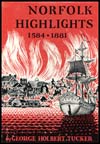Chapter 37
Two Memorable Freezes
Two memorable freezes gripped Norfolk in their icy clutches during the Eighteenth and Nineteenth Centuries. The first was the rigorous winter of 1779-80, during which the Elizabeth River was frozen solid for several weeks and the Chesapeake Bay was so thickly frozen that teams crossed from shore to shore as far down as Cape Henry.
It was also during this freeze that the coldest morning ever known in Virginia since the time of the first settlement was experienced. On January 14, 1780, the mercury dropped into the bulbs of the thermometers, while ice piled up twenty feet high along the Atlantic Coast in Princess Anne County and remained there until mid-May.
Seventy-seven years later Norfolk area citizens who liked to bend the elbow were treating themselves to the unique experience of taking a hot toddy at a temporary bar set up in the middle of the Elizabeth River.
It all began on Friday, January 16, 1857. Although there had been several inches of snow and the usual bad weather on New Year's Day, the editor of The Southern Argus, on the strength of "two delicious mint julips from the Anchor Bar," had forgotten it sufficiently to hail the first signs of spring. By the next morning, however, the wind has veered around to the northeast, and at half past seven snow began to fall rapidly. By noon the temperature had dropped to an all-time low and a furious gale sent snowflakes whirling in all directions. The great blizzard and freeze of 1857 were on!
Two days later, Norfolk and Portsmouth were buried under twenty-foot snowdrifts, and the damage of the storm to the two cities was roughly estimated at one hundred thousand dollars. Added to that, the Elizabeth River was a blinding surface of hard, gray ice, while the cold had become so intense that all of the Virginia Rivers and Hampton Roads were ice-bound.
Chesapeake Bay was frozen solid for a mile and a half from the shoreline, and at Cape Henry it was possible to walk out a hundred yards on the frozen ocean from the lighthouse.
The suffering among the Norfolk-area poor was terrible, but in middle-income and well-to-do Norfolk families an ice carnival spirit prevailed.
Sleighing and skating parties were organized throughout the community, and a pair of skates, a sled, or a sleigh of any description sold at a premium.
On January 26, 1857, the Argus announced that many persons had walked all the way down to Hampton Roads on the ice over the weekend, while one hardy soul had strolled twenty miles from Nansemond County on the ice, had dined with the captain of an ice-bound steamer off Craney Island, and had then finishd his promenade to Norfolk.
"Our harbor has been converted into a magnificent panorama," the Argus commented. "On Saturday, belles and beaux, husbands and wives, parents and children all crowded the thoroughfare on the ice between Norfolk and Portsmouth."
Then came the real news of the day: "A booth was erected about midway of the journey where thirsty souls imbibed the ardent, and a brisk trade was carried on beneath it.
This was the famous "bar in the center of the river," part of the folklore of every Nineteenth Century Norfolk-area person.
Needless to add, "the ardent," as the editor of the Argus referred to the liquid refreshment served over the bar on the ice, was the cause of many fights and cases of unsteady legs. And according to tradition, although the editor of the Argus had nothing to say concerning it, a free black family in Portsmouth pressed their small donkey cart into service and piled up a tidy little sum transporting the drunks backward and forward to terra firma.
By January 28, 1857, however, the thaw had begun, and the next day the ferryboat made several cautious crossings through a path cut through the melting ice. With things back to normal, the ice carnival spirit quieted down, and was not revived until the big freeze of 1917-18, when the harbor again became a solid mass of ice between Norfolk and Portsmouth.
Chapter
38
Landmark of Loveliness
Norfolk Highlights 1584 - 1881

See the "Table of Contents" for links to every chapter in Norfolk Highlights 1584 - 1881 by George Holbert Tucker.
